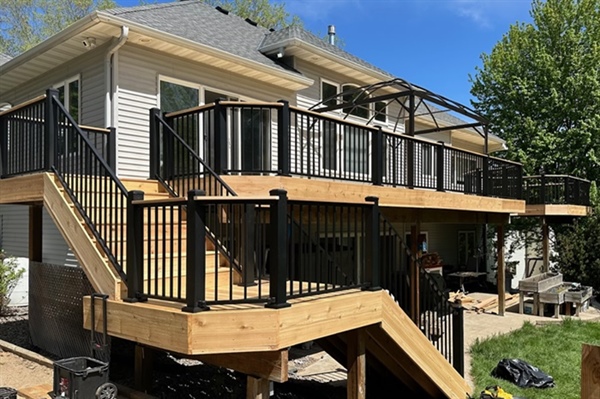Stop Deck Pests With BigDeck.com's Safe & Effective Methods

Decks are a beloved part of many homes, providing a relaxing outdoor space to enjoy with family and friends. However, decks can also attract unwanted pests, which can cause damage to the structure and diminish your enjoyment of the space.
BigDeck.com offers safe and effective methods to help homeowners keep their decks pest-free and well-maintained. By understanding the types of pests that commonly affect decks, how to prevent infestations, and methods for repairing pest-related damage, you can ensure your deck remains a beautiful and functional outdoor area.
In this article, we’ll explore the common pests that affect decks, provide prevention strategies, discuss safe and effective pest control methods, and explain how to repair pest damage. We will also offer tips on how to maintain a pest-free environment so that your deck continues to be a place of relaxation and enjoyment.
What Are Common Pests That Affect Decks?
Various pests can wreak havoc on decks, including termites, carpenter ants, wood-boring beetles, and even rodents. Termites are notorious for feeding on wood, and once they infest a deck, they can cause significant structural damage. Carpenter ants also bore into wood, creating tunnels that weaken the integrity of the deck. Wood-boring beetles lay eggs inside wood, and their larvae consume the wood as they grow, further contributing to the deterioration of your deck.
Other pests, such as rodents, may use your deck as a nesting spot, especially in the colder months. They can chew through wood, wiring, and even insulation. Understanding which pests are most likely to cause damage in your area is key to protecting your deck from costly repairs.
To minimize the chances of infestation, you should stay vigilant for signs of pest activity, such as sawdust-like material near wood surfaces, small holes, or weakened areas in the wood.
How to Prevent Pest Infestations?
Prevention is the best defense against pest infestations. One of the most effective ways to prevent pests from invading your deck is to use pressure-treated wood or composite materials, as these are less attractive to wood-eating pests like termites and carpenter ants. Sealing your deck with a high-quality sealant also creates a protective barrier against moisture and insects, which can help keep pests at bay.
Regular cleaning and maintenance can make your deck less appealing to pests. Ensure you remove debris such as leaves, dirt, and food scraps, as these can attract pests. Keeping plants and shrubs trimmed back from the edges of your deck will also limit pests' access to the structure.
Another way to prevent infestations is to inspect your deck regularly for any signs of pest activity or damage. Early detection can help prevent a minor problem from becoming a major infestation. If you’re building a new deck, consider custom decks that are designed with pest-resistant materials from BigDeck.com.
What Are Safe and Effective Pest Control Methods?
When dealing with pests, it’s important to use methods that are both safe for your family and the environment while being effective in controlling the infestation. Chemical treatments, such as insecticides, can be effective, but many homeowners prefer natural alternatives to protect children, pets, and the surrounding ecosystem.
Boric acid is a commonly used treatment for pests like termites and carpenter ants. It’s a natural substance that is less toxic to humans and animals but highly effective in eliminating wood-destroying insects. Diatomaceous earth is another natural option that can be applied around the deck to deter pests. It works by damaging the exoskeletons of insects, causing them to dehydrate and die.
How to Repair Pest Damage to Your Deck?
Repairing pest damage to your deck depends on the extent of the damage and the type of pest involved. For minor damage, such as small holes or surface scratches caused by wood-boring insects, you can fill these areas with wood filler and then sand the surface smooth before reapplying a sealant. This will restore the aesthetic appearance of the deck and prevent further damage.
In cases of more extensive damage, such as significant structural weakening due to termite activity, it may be necessary to replace entire sections of your deck. You’ll need to inspect the affected areas carefully to ensure all compromised wood is removed and replaced with new, treated lumber or composite materials that are less susceptible to pest infestations.
If you’re unsure how to handle the repairs, a professional deck repair company can assess the situation and recommend the best course of action to restore your deck to its original condition.
How to Maintain a Pest-Free Deck Environment?
Maintaining a pest-free deck requires a combination of regular cleaning, maintenance, and vigilance. Make it a habit to clean your deck at least once a season to remove any debris that may attract pests. Trimming back plants around your deck can also reduce the likelihood of pests making their way onto the structure.
Another important aspect of deck maintenance is applying a protective sealant every couple of years. This will not only enhance the longevity of your deck but also serve as a barrier against pests and moisture. Inspect your deck frequently for any signs of pest activity, and take immediate action if you detect any problems.
BigDeck.com offers a range of services and products that can help you maintain your deck and keep it pest-free. For more information on how BigDeck.com can help you with deck maintenance, contact us today at 612.432.7761 to consult with our decking experts!